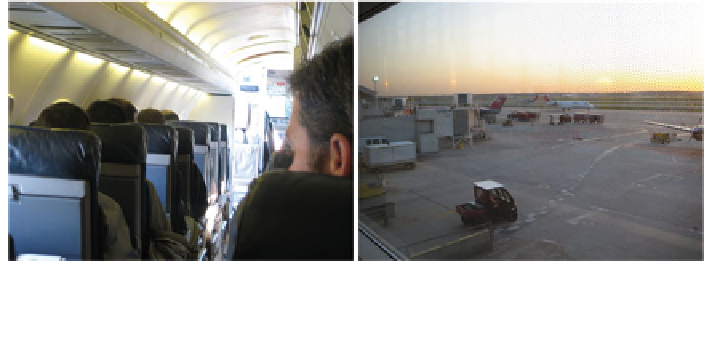Information Technology Reference
In-Depth Information
Fig. 8.1 The modern air transportation system includes many kinds of technology, including
computer systems, and many types of users, ranging from passengers to pilots to support staff and
including air traffic control
the flight deck. The concept was subsequently extended to cover the whole of the
on-board flight crew, and was renamed crew resource management (Kanki et al.
2010
). When teams are in the same location, or co-located a great advantage is
overhearing what others are doing, even if they are not collaborating actively at
that moment. This allows people to be aware of where others are in a task. There is
a body of work looking at what happens in control rooms, for example, where
teams of operators work together (e.g., Heath and Luff
2000
).
Although teams may be co-located, teams nowadays are often distributed in
space and time, even when working for the same organization. Teams may also be
spread across different time zones and across different cultures. A lot of work has
been done to understand the benefits and problems of distributed work and tele-
commuting (see, for example, Hinds and Kiesler
2002
; Ellison
2004
). Research
has also focused on the ways in which different technologies affect communication
and coordination. Technologies that mediate communication between people in
different locations are differentially suited to different kinds of tasks (Churchill and
Bly
2000
). Teams can also change dynamically, as they adapt to the situation at
hand. In hospitals, for example, there is often a doctor that is on call. These doctors
are usually only called up when the local team cannot resolve the case they are
currently dealing with. This may result in the doctor acting as a remote team
member to help diagnose and fix the situation, or it may result in the doctor
physically attending in order to provide expertise and advice in situ.
In the rest of this chapter we look at the impact of social factors on perfor-
mance. We begin by examining at the impact of the social context on decision
making. We then go on to consider the factors that define the social context in
which teams operate. It is worth noting at this juncture that team performance
involves more than just the sum of the performances of the individual team
members.

Search WWH ::

Custom Search